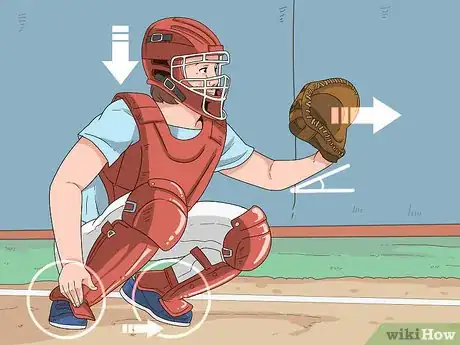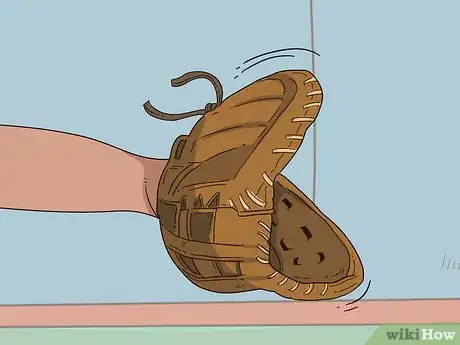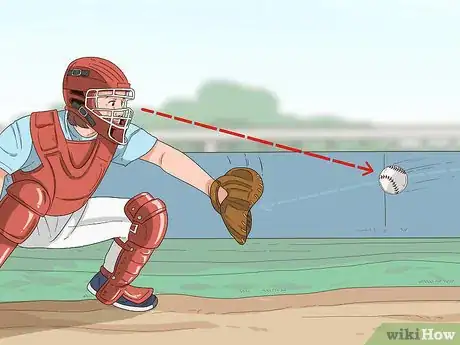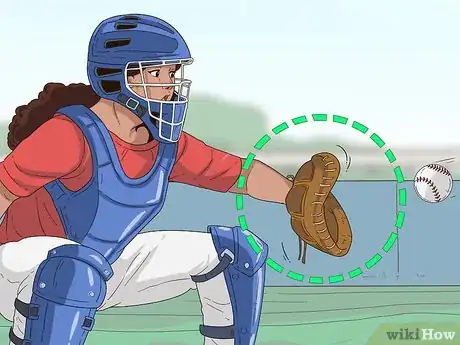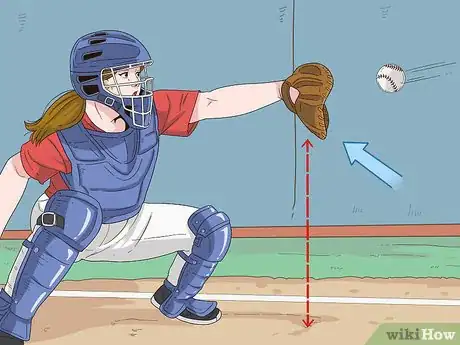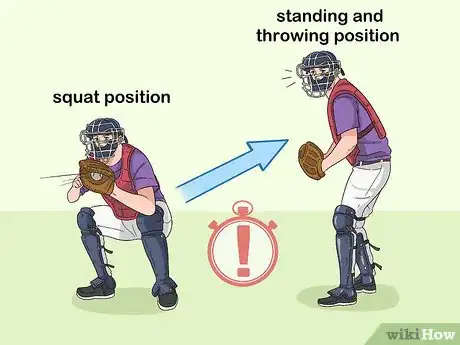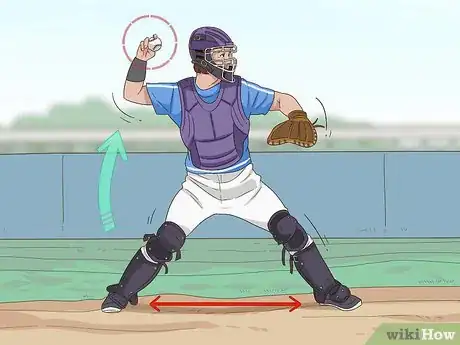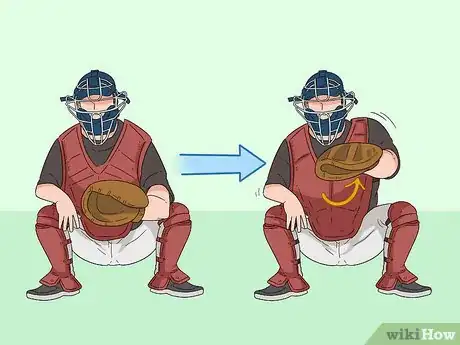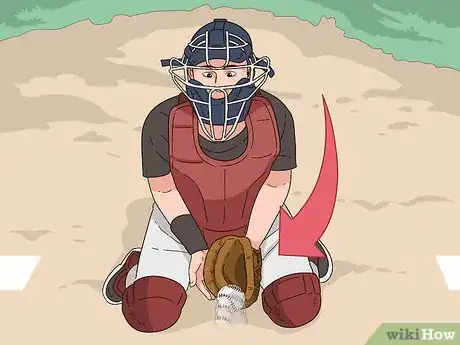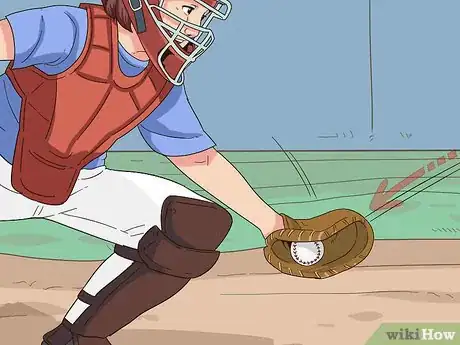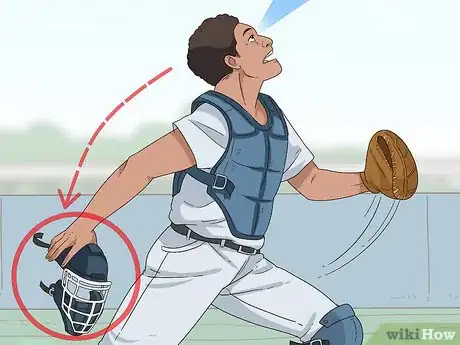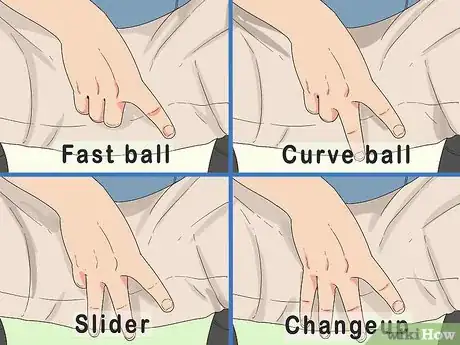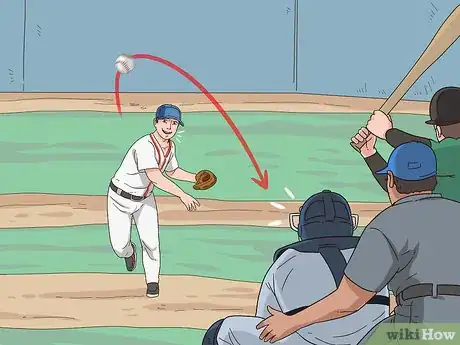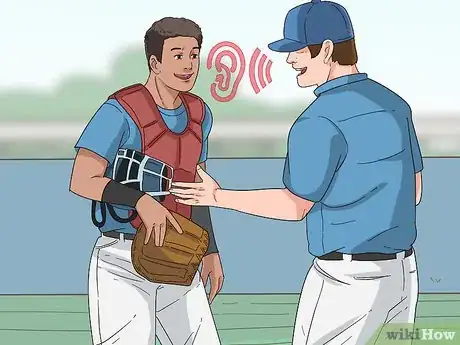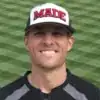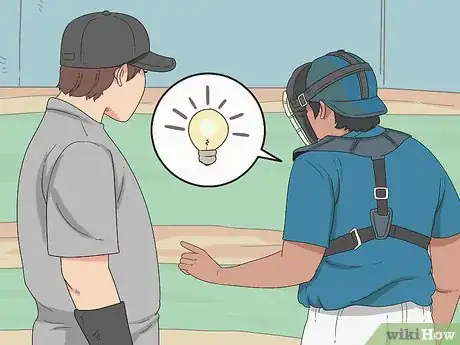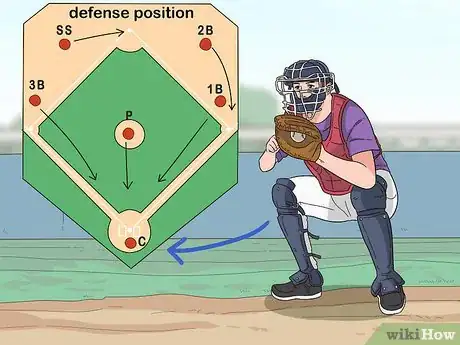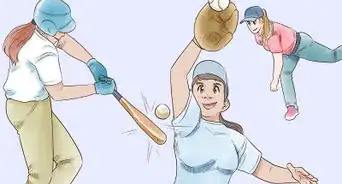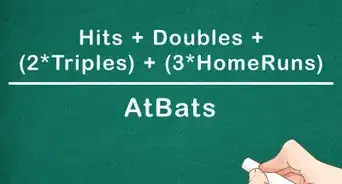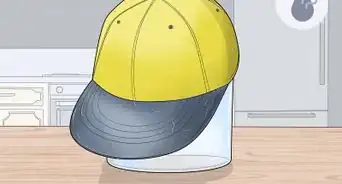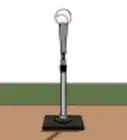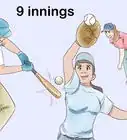This article was co-authored by Isaac Hess. Isaac Hess is a Baseball Coach, Instructor, and the Founder of MADE Baseball Development and Champion Mindset Training Program, a baseball training program based in Los Angeles, California. Isaac has over 14 years of experience coaching baseball and specializes in private lessons and tournaments. He has played baseball for both professional and collegiate leagues including Washington State University and the University of Arizona. Isaac was ranked as one of Baseball America's top 10 prospects for 2007 and 2008. He earned a BS in Regional Development from the University of Arizona in 2007.
This article has been viewed 96,563 times.
The catcher is perhaps the most important defensive player on a baseball team. Not only does the catcher guard home plate, but catcher works with the pitcher and other players to coordinate the team’s defense. Ultimately, though, there are a lot of challenges to being a successful catcher. Thankfully, by perfecting the basics of catching, positioning yourself, and being a team player, you’ll know your job as a catcher in baseball.
Steps
Positioning Yourself
-
1Squat and position your arms. Your normal position is squatting behind home. When doing this, your left foot should be a little bit in front of your right foot (an inch or two). Your left arm (catching arm) should be bent a little at the elbow. Avoid holding your elbow on the inside of your left knee.
- Straddle the plate, but do not block it. You should allow an open lane to the plate. The only time you can block the plate is when you have the ball in hand.[1]
-
2Keep your glove still. It is very important that you keep your glove as still as possible from the time the ball hits your glove until the umpire makes the call. Moving your glove even slightly can cause a good strike to be a ball.Advertisement
-
3Keep your eyes on the ball. At all times during the game, you need to keep your eyes on the ball. Without watching the ball, you won’t be able to position yourself appropriately to catch the ball. In addition, you could put yourself in danger of being struck by the ball or the bat.
-
4Relax your arm. Before catching a ball, you need to relax your arm. If your arm isn't relaxed, the impact of the ball could hurt you. After you relax your arm, focus on where the ball is headed.
-
5Position your arm and mitt. Once you've identified the height at which the ball is approaching, you should position your arm appropriately and open your mitt. In addition:
- If you know the pitcher is pitching high, position your arm and glove high.
- You’ll want to move your whole body to receive the pitch (not just your glove). This will help you better catch it. This tactic is known as swaying.
- Don’t move while the pitcher is throwing. You’ll distract them.
- If the ball is a definite strike, make sure to extend your arm and catch it with a straight elbow.[2]
-
6Adjust quickly to a standing and throwing position. To best throw out runners, you’ll need to practice quickly moving from the squatting position to your feet. Practice quickly bouncing from a squatting or kneeling position to a standing position. To do this, use your legs to spring upward.
- When trying to throw out a runner, make sure to use proper footwork. You should catch the ball and crow hop in place. Catching the ball and then taking a step and throwing it gives the runner an extra second.[3]
-
7Transfer the ball from your glove to your throwing hand. After catching a ball, you’ll have to hone your skills at transferring it to your throwing hand so you can out runners. This is because you’ll need to quickly deliver a ball you’ve caught to the first, second, or third basemen (or others).[4]
- While transferring the ball from glove to throwing hand, make sure not to bring your glove all the way back to your shoulder. You should catch the ball, make a quarter turn, and take the ball out. If you bring the glove all the way back it makes the transfer a lot harder and you'll frequently have to double clutch.
Catching the Ball
-
1Frame the ball. Framing the ball is a tactic of making it so the umpire can see the ball from a certain angle. Framing is often used when it might be ambiguous as to whether the ball is a strike or is not. There are several keys to framing a pitch:
- Give the umpire a view of the ball from the angle that makes it look like a strike. Do this by moving your body and hands slightly. For example, if the pitch could be a ball or strike, try to catch the outside of the ball and slightly twist your wrist as you move your arm outward.
- Move your arm and glove forward a couple inches after you catch it.[5]
-
2Block dirt balls. If you think a ball will hit the dirt and bounce, you need to quickly position yourself to get the ball. Try to move yourself slightly toward the ball. In addition, position your legs so you can quickly spring toward the ball.
- You may need to drop to your knees so you can better lean in toward the ball.
- Depending on the trajectory of the ball, you may need to duck your chin down to protect your neck.
- Don’t move too much. You could wind up getting hit by the ball or the bat.[6]
-
3Scoop up balls that fall just short of you. Much like with catching dirt balls, acquiring a ball that falls a little short of you is very important. The quicker you get the ball, the quicker you can stop your opponents from advancing. To scoop the ball, move toward it and scoop downward with your glove and use your throwing hand to direct the ball into your glove.[7]
-
4Remove your helmet to catch pop ups and fouls. When it comes to catching pop ups and fouls, you’ll have to quickly remove your helmet, stand up, and catch the ball. This is important, as it will give you the mobility and the ability to see the ball.
-
5Use signs. As a catcher, you’ll have provide hand signs to the rest of your team about possible defensive plays. Signs may vary, as you don’t want the opposite team to know what you’re going to do. Some signs include:
- One finger for a fast ball, two fingers for a curve ball, three fingers for a slider, and four fingers or wiggle fingers for a changeup.[8]
Being a Team Player
-
1Collaborate with the pitcher. You and the pitcher are fundamentally a team within the larger team. To properly collaborate, you’ll need to forge real communication with the pitcher. Be sure they know your hand signs. In addition, know which type of balls your pitcher can throw the best.[9]
-
2Hone your leadership skills. In many ways, the catcher is a defensive coordinator for the team. As a catcher, you’ll need to be able to effectively communicate with your team mates and to send them signals during the game. You’ll also have to be supportive and mentor weaker players.[10]
- Talk to your teammates before the game.
- Avoid making defensive success or failure about any one person. Encourage everything to work together as a team.
-
3Educate yourself about your teammates’ strengths and weaknesses. To be a successful leader and catcher, you’ll need to observe and talk to your teammates to find out their strengths and weaknesses. Without knowing these, you won’t be able to mount a proper defense.
- Focus your attention on pitchers and basemen.[11]
-
4Plan the defense. As catcher, you’ll have a large responsibility in planning your team’s defense. You’ll have a say in which players are on the bases, you’ll be able to give your basemen a sense of where and who they should throw balls to, and more. As a result, take the time to reflect on your overall defense.[12]
Expert Q&A
-
QuestionHow can I develop better arm strength as a catcher?
 Isaac HessIsaac Hess is a Baseball Coach, Instructor, and the Founder of MADE Baseball Development and Champion Mindset Training Program, a baseball training program based in Los Angeles, California. Isaac has over 14 years of experience coaching baseball and specializes in private lessons and tournaments. He has played baseball for both professional and collegiate leagues including Washington State University and the University of Arizona. Isaac was ranked as one of Baseball America's top 10 prospects for 2007 and 2008. He earned a BS in Regional Development from the University of Arizona in 2007.
Isaac HessIsaac Hess is a Baseball Coach, Instructor, and the Founder of MADE Baseball Development and Champion Mindset Training Program, a baseball training program based in Los Angeles, California. Isaac has over 14 years of experience coaching baseball and specializes in private lessons and tournaments. He has played baseball for both professional and collegiate leagues including Washington State University and the University of Arizona. Isaac was ranked as one of Baseball America's top 10 prospects for 2007 and 2008. He earned a BS in Regional Development from the University of Arizona in 2007.
Baseball Coach & Instructor Do push ups every other day to build your upper arm strength. You can also do some basic dumbbell exercises, like shoulder raises or side shoulder raises. You can also use tubing or Jaeger bands to build your throwing arm. The most important thing is to throw regularly. Get out and toss the ball around, play long catch, and just get in the habit of throwing the ball.
Do push ups every other day to build your upper arm strength. You can also do some basic dumbbell exercises, like shoulder raises or side shoulder raises. You can also use tubing or Jaeger bands to build your throwing arm. The most important thing is to throw regularly. Get out and toss the ball around, play long catch, and just get in the habit of throwing the ball. -
QuestionWhat if you miss the ball completely, is there a procedure?
 DonaganTop AnswererA missed ball is a live ball. It's still in play, so if there are any base runners at the time, you have to retrieve the ball immediately, because the runners are free to run to the next base whenever they want. (If a runner advances, the missed ball is called a "passed ball" -- or a "wild pitch" if it's not considered catchable.) If the missed ball gets stuck in the backstop or leaves the field of play, the ball is dead, and all play stops. If there are no base runners at the time of the missed ball, you can take your time retrieving it.
DonaganTop AnswererA missed ball is a live ball. It's still in play, so if there are any base runners at the time, you have to retrieve the ball immediately, because the runners are free to run to the next base whenever they want. (If a runner advances, the missed ball is called a "passed ball" -- or a "wild pitch" if it's not considered catchable.) If the missed ball gets stuck in the backstop or leaves the field of play, the ball is dead, and all play stops. If there are no base runners at the time of the missed ball, you can take your time retrieving it. -
QuestionHow can I catch wild pitches?
 DonaganTop AnswererThat's one of the hardest things a catcher has to do. If a pitch is in the dirt, the catcher must block the ball with his mitt or protective equipment. If the pitch is wildly high or away from the plate, the catcher must react quickly to stop the ball with his mitt.
DonaganTop AnswererThat's one of the hardest things a catcher has to do. If a pitch is in the dirt, the catcher must block the ball with his mitt or protective equipment. If the pitch is wildly high or away from the plate, the catcher must react quickly to stop the ball with his mitt.
Warnings
- Don't get too close to the batter. Being hit with the bat is painful and can result in serious injury. It will also result in a call of catcher's interference and a free base for the batter. To determine if you are far enough back, you should be able to completely stretch out your arm and touch the back of the batter's shoe (left arm for right handed batter, right arm for left handed batter).⧼thumbs_response⧽
References
- ↑ http://www.qcbaseball.com/skills/catching-squat-position.aspx
- ↑ http://www.qcbaseball.com/skills/catching-squat-position.aspx
- ↑ http://www.qcbaseball.com/skills/catching-squat-position.aspx
- ↑ http://www.qcbaseball.com/skills/catching-squat-position.aspx
- ↑ http://www.qcbaseball.com/skills/catching-squat-position.aspx
- ↑ http://www.qcbaseball.com/skills/catching-squat-position.aspx
- ↑ http://www.qcbaseball.com/skills/catching-squat-position.aspx
- ↑ http://www.baseball-catcher.com/guide/signals.htm
- ↑ http://www.qcbaseball.com/skills/catching.aspx
- ↑ Isaac Hess. Baseball Coach & Instructor. Expert Interview. 20 March 2020.
- ↑ http://www.qcbaseball.com/skills/catching.aspx
- ↑ http://spiderselite.com/2015/08/18/responsibilities-of-a-catcher/#
